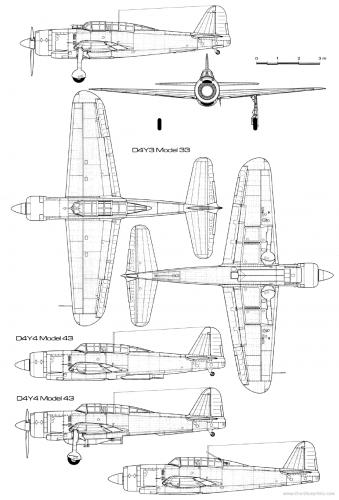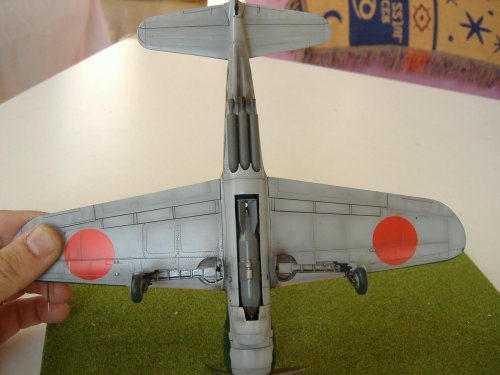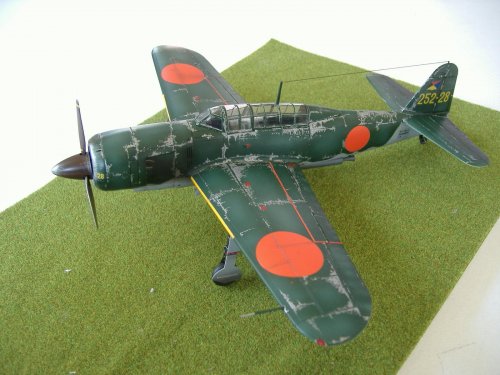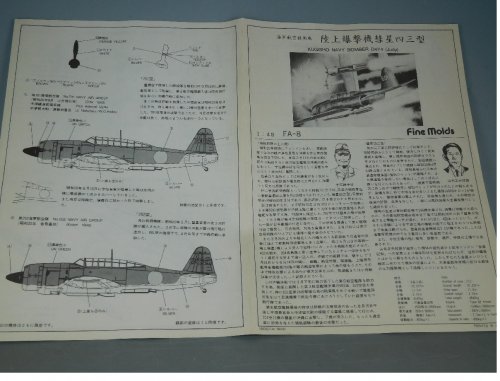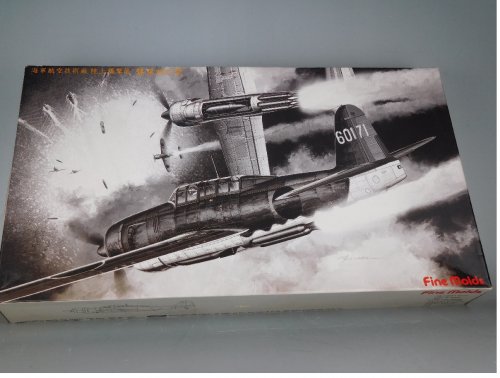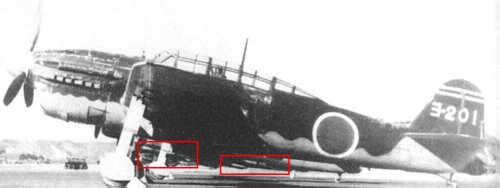When the Japanese Government acquired the production licence of the in-line Daimler-Benz DB 601A engine in 1940, the main manufacturers of fighters made plans to create an interceptor that was faster and had higher ceiling. The IJN was not initially interested in the possibilities offered by the German engine, as the Zero was superior to all the Allied fighters operating in the Far East.
Future combats in defence of the Fleet were expected to take place at medium and low altitude, against slow Swordfish and Devastator torpedo airplanes, with a pathetic escort of Buffaloes. But the Val dive bomber was also getting out of date and the new in line engines of the Atsuta series offered to the aircraft carriers the possibility to use reconnaissance and dive bomber airplanes that were faster than the Fulmars and Wildcats that defended the Allied fleets.
Therefore, the Aichi firm was commissioned to build two versions of the D4Y1 Suisei (reconnaissance and dive bomber) powered by an Atsuta 12 of 1,100 hp, to be replaced by the Atsuta 32 of 1,400 hp in the second series, the D4Y2. The design of the Suisei was based on the combat experiences of the Ju 87 in Europe and on its failure against the British fighters when used in strategic missions.
The Japanese engineers reached the conclusion that the robust building and little refined aerodynamics of the German dive bombers were not compatible with the local manufacturing systems. The new airplane manufactured by Aichi had a bomb bay to internally transport the bombs and both the undercarriage and the airbrakes were fully retractable within the wing. Being faster than the Zeros and the Allied fighters of the time, the airplane was expected to operate without any escort.
Unfortunately for Japan, the adaptation of German technology, the development of new engines and their integration with the airframe, required more time than had been foreseen and the Suisei were not sent into combat until mid-1944, sent against Hellcats and Seafires guided by the interception radar of the powerful Allied Task Forces!
During the Battles of the Philippine Sea and Leyte Gulf, the Suisei were virtually annihilated, together with their inexperienced crews, and the IJN decided to use the surviving airplanes in suicidal missions. The transformation was made in several stages, of increasing complexity, incorporating the experience obtained in the fighting that was getting progressively nearer to Japan.
The first Tokko modification affected the dive bombers of the D4Y1 and D4Y2 versions. The extended yoke within the bomb bay that avoided the bomb colliding with the propeller during a dive attack was eliminated. It was replaced by the attachment devices for an anti-ship Type 2 Number 50 Model I bomb of 491 kg. The rear gunner and its flexible machine gun were also removed, keeping just the two 7.7-mm Type 97 weapons above the engine. When using an airstrip of the right length, the Suisei could take off with the bomb and two detachable fuel tanks of 310 litres each under the wings. The bomb partially protruded under the fuselage, with the intention of releasing it after the impact, penetrating in depth the structure of the ship.
After the Midway defeat, the IJN understood that the reconnaissance catapult-launched floatplanes, used up to then by the battleships, had no future among the new war of aircraft carriers. They needed a high range and sufficiently fast airplane to escape the Allied fighters. The answer seemed to be the new Kawanishi E15K Shiun, a single engine reconnaissance floatplane planned to equip a new class of cruisers of the Oyodo series. The stabilising inflatable floats were designed to retract into the wing, while the central float could detach in an emergency, to be able to reach 90 kph of maximum speed
Unfortunately for the Japanese, the Shiun proved to be a failure. The six available units were sent into combat and they were shot down by Allied fighters when the ejection mechanism of the main float systematically failed. The production of the Shiun was cancelled in February 1944 after just 15 units had been manufactured.
The next option would be to use a semi-expendable airplane similar to the catapultabile Reggiane Re.2000 used in the Mediterranean by the cruisers of the Italian Regia Marina. These airplanes landed in a ground base or were abandoned at sea after each mission. The Japanese version used the D4Y2 because a Zero converted into a twin seat would have been too slow. The new airplane, fitted with catapult equipment, could be launched from any battleship, with two underwing fuel tanks of 330 litres each, and accomplish most of the reconnaissance missions required in future confrontations between fleets. Named D4Y2 KAI Mod.22, it could carry a 250 kg bomb inside the airplane, or two K-8 photographic cameras, at a maximum (clean) speed of 570 km/h. Some units of the non-catapult-launched D4Y2-KAI-Ko Mod.22, equipped with RATO rockets to take off from small auxiliary aircraft carriers or from the rear deck of the aircraft carrier/battleship Ise and Hyuga were also built.
According to some authors, they used only two detachable rockets, possibly the new Toku-Ro.1 Type 3 specifically developed for the IJN that were installed under the engine. The Mod.22 could take off from a very short strip, carrying a bomb of 250 kg.
German technology did not adapt well to the complex systems of Japanese manufacturing. The in line engines of the Atsuta series were built in such a way that proved to be lighter than their Daimler-Benz counterparts, but also more fragile and difficult to maintain. The D4Y programme aimed to achieve a fast reconnaissance carrier based airplane and it was never considered during the first phases that it might generate any issues, because it involved a reduced number of very sophisticated machines that operated in good maintenance conditions from the best ships of the IJN.
When the mass production of the dive-bomber version was decided, the airframe proved to be too light. Its longitudinal resistance had to be increased and its engine mount reinforced. After the loss of almost all their aircraft carriers in the Battle of Leyte gulf, the D4Y2 started operating from ground bases under very rudimentary conditions and using fuel of very low quality. The problems of the Atsuta aggravated, considerably reducing the number of available airplanes.
As it happened with the Ki.61 fighter of the IJA, the solution was to use the much more reliable and powerful Kinsei 62 radial engine for the new version D4Y3 Mod.33. Albeit a bit slower than its predecessor but without any problems to operate from ground airfields, it proved to be the ideal airplane for Tokko missions. It carried a Type 2 Number 50 Model I bomb (with tailfins) fixed externally and two detachable 310 litres fuel tanks under the wings. In a subsequent version D4Y4 Mod.43, based in the combat experience, the rear gunner and all the machine guns were omitted. That made it lighter and allowed the installation of a Number 80 Model 2 bomb of 807.5 kg, keeping the tailfins to preserve longitudinal stability.
To accommodate the bomb, it was necessary to cut a section of 62-cm of the rear fuselage, after the bomb bay. Since October 1944 onwards, the D4Y was very active as suicidal bomber: at least 55 units of the D4Y2 models and 132 of the D4Y3 made Tokko missions against Allied ships. Some of these fast airplanes were crewed by naval pilots and expert observers that traced the position of the Task Forces, guided the suicidal airplanes towards them and informed the IJN of the results of these attacks. The D4Y2 maintained a special collaboration with the Zeros of the Kongo, Yamato and Mitate suicidal units as well as with the IJA Ki.46 of the Shinbu Sakura.
Almost all the D4Y3 were transformed in single seat airplanes to accommodate a bigger bomb. They were used by the Special Attack Groups Chuyu, Giretsu, Minatogawa, Katori, Niitaka, Mitate, Kikusui, Chusei, Suisei, Kasuga, Chihaya, Kyokujitsu, Koroku and 210th Kokutai.
On November 27, 1944 a D4Y3 of the Kasuga unit, escorted by Zeros, attacked the cruiser CL-49 St. Louis in Leyte Gulf.
On March 25, 1945 a D4Y3 of the Koroku Suisei unit attacked the destroyer DD-521 Kimberly off Okinawa.
On April 6 a Suisei of the Mitate Unit No. 3 (252 Ko), escorted by two Zeros, attacked the CV-7 Illustrious 70 nautical miles from Amami Oshima.
On April 7 eleven D4Y3 airplanes of the Mitate Unit No.3 (601 Ko) attacked the Allies carrier task force 110 nautical miles from Okinawa Island, damaging the BB-46 Maryland battleship
On April 11 three Suiseis of the Mitate Unit No.3 (252 Ko), escorted by two Zeros, attacked the Allies carrier task force 100 nautical miles from Amami Oshima causing damages to the CV-6 Enterprise.
Once they knew the performance of the D4Y3, the IJN decided to assign most of the available airplanes to the modifications programme Kokoku Heiki Go.1, with priority to use the new Toku-Ro rockets, leaving unmodified just a few of machines that were dedicated to liaison and training. The idea of using RATO rockets was based on the experience obtained with the D4Y2a KAI Mod.22A in short take off. But the Kokoku Heiki programme also considered the use of rockets to increase speed when facing the Allied fighters and during terminal dive.
The final suicidal version D4Y4 Mod 43 KAI was powered by a Kinsei 62 and armed with two Type 97 machine guns of 7.7-mm positioned above the engine, to defend against the fighters and help correct the path during the terminal dive. It was a single seat airplane, with the rear canopy covered by metal and armoured devices (front and rear) for the pilot. The 807.5 kg bomb was screwed into the fuselage. The tailfins of this bomb have been removed to make room for the three RATO rockets, fixed into special mounts under the fuselage, behind the bomb bay. The rockets were Toku-Ro.1 Type 2 with 600 kg peak thrust each and 30 seconds of life. To offset the lack of tailfins in the bomb, the surface of the vertical tailplane was increased and the wingtips were removed, to gain some extra speed. Four tubes were also installed under the wings for the I.S.R. rockets of 12-cm that were frequently used to disrupt the visibility of the Allied AA gunners during the terminal dive.
At the end of the war the Aichi engineers were working on the D4Y5 Mod.54, with the same Homare 12 engine than the B7A Ryusei, four bladed metal propeller, more armour protection and 1,764 kg of bombs with a mechanical detonator device.
Night fighter variants
By mid-1944, around a dozen of D4Y2 airplanes were transformed into two seat night fighters D4Y2-S to fight against the B-29. The night fighter conversions were made at the 11th Naval Aviation Arsenal at Hiro. They had a Type 99 Mod 2 cannon of 20-mm in a 30-degrees angle, Schräge Musik configuration and two Type 3 Mk.27 rocket bombs of 60 kg under the wings.
This lighter version of the Suisei was also the fastest, with a speed of 580 km/h and a ceiling of 10,700 m and it was expected to achieve success in combat. But one cannon of 20-mm was not enough to face the gigantic Boeing bomber. The Luftwaffe statistics show that they needed to make at least 36 impacts in vital points to bring down a B-29. It would have been necessary to shoot 200 rounds with a Type 99 cannon from a distance of 1,000 m to make it, and that staying several minutes under the formation of bombers and flying in their same direction, instead of performing a unique frontal attack, as the IJA recommended.
After the technical valuation of the Yokosuka Kokutai, at the beginning of 1945, nine airplanes were sent to the 302nd Kokutai of Atsugi, for combat testing, and another three to the 131st of Kanoya by mid-April. At least two pilots of the 302nd Kokutai, Yoshimitsu Naka and Takaji Inumaru, claimed B-29 shot downs thanks to lucky impacts of the rarely accurate bomb-rockets Mk.27, possibly on 14 and 25 May 1945.
The D4Y3-S was a project only variant powered by a Kinsei 62.
The D4Y2-S performances were not considered enough by the IJN and one Suisei Type 12 was modified, as high-altitude experimental aircraft, at the Engine Department of Kugisho. One Hitachi 92 turbocharger was mounted under the bomb bay and connected from the engine exhaust pipes by means of two ‘S’ ducts. The Japanese defeat was received during the experiment preparations at the Oppama airfield.
No ramming attacks are known to have been made with this model.
D4Y2-S Model 12 technical data
Wingspan: 11.5 m, length: 10.22 m, height: 3.63 m, wing area: 23.6 sq. m, max weight: 4,750 kg, estimated max speed: 580 km/h, estimated service ceiling: 10,700 m.
